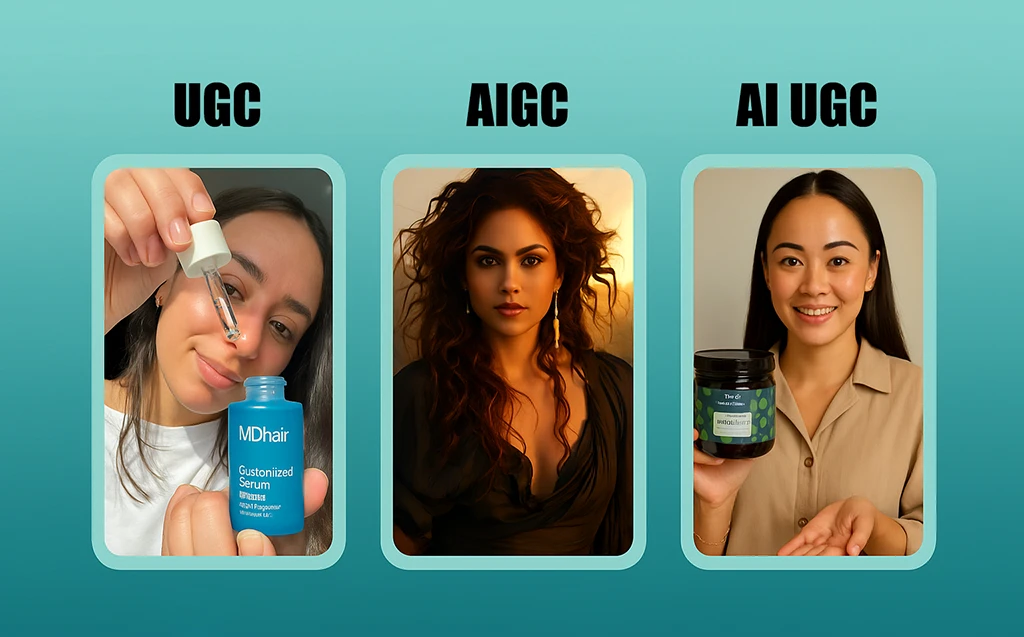
Understanding the Key Differences Between UGC, AIGC, and AI-UGC
Whether you’re scrolling through Instagram, reading a blog, or watching YouTube, you’ve probably come across a term like UGC or seen a video made by AI. But what exactly are UGC, AIGC, and AI-UGC? And how do they differ?
Don’t worry — we’re going to break it all down using simple language and real-world examples so that by the end of this post, you’ll know exactly what each term means and how it’s changing the way we create and consume content.
What is UGC (User-Generated Content)?
Let’s start with the classic: UGC, or User-Generated Content. This refers to any type of content — like photos, videos, reviews, or posts — that is created and shared by everyday users, not brands or professional creators. Think about:
- Your cousin posting a video of their latest recipe on TikTok
- A happy customer leaving a positive review on a small business’s Facebook page
- Someone uploading vacation photos with a brand’s hashtag
UGC is powerful because it feels real and authentic. People trust it more than traditional ads because it comes from actual users instead of companies trying to sell something.
Why is UGC important?
It builds trust. When you see someone just like you using a product and loving it, it feels more convincing than a polished ad. That’s why brands love sharing user-created posts. Plus, UGC adds a personal touch to marketing.
What is AIGC (AI-Generated Content)?
Next up is AIGC, which stands for AI-Generated Content. This is all about content made entirely by artificial intelligence. For example, AI tools can now write articles, compose music, design images — even create videos!
Some popular AI generation tools include:
- ChatGPT (for text)
- DALL·E or MidJourney (for visual art)
- Runway or Synthesia (for video content)
AIGC is fast, efficient, and scalable. It can create a ton of content in a short time, which is a big plus for businesses. But it sometimes lacks the human emotion or personal touch that comes with real-life experiences — the kind you get from UGC.
Think of it this way: If UGC is like a handwritten letter, AIGC is more like a printed newsletter. Both can share information, but one feels more personal than the other.
What is AI-UGC (AI-Assisted User-Generated Content)?
Now here’s where things get interesting: AI-Assisted User-Generated Content or AI-UGC. This is the new hybrid on the block. It blends AI tools with human creativity to produce content.
Basically, a person still creates the content — but they get help from AI tools to brainstorm, enhance, or produce it. It’s teamwork between the user and the machine.
What does AI-UGC look like in real life?
Imagine you’re recording a YouTube video. You use an AI tool to generate a catchy title, help write the script, and maybe even edit the video. That final content still has your personality, voice, and vibes — but it’s been supercharged by AI.
Some common examples of AI-UGC:
- Using ChatGPT to write your Instagram captions
- Employing AI filters or avatars for your TikTok videos
- Getting AI suggestions while writing a blog post or creating art
This blend brings out the best of both worlds: human personality and AI-driven efficiency. The result? Faster content creation without sacrificing that emotional connection.
UGC vs AIGC vs AI-UGC: Key Differences
Let’s put it all together with a quick breakdown of how these three types of content differ:
| Aspect | UGC | AIGC | AI-UGC |
|---|---|---|---|
| Created By | Humans | Machines | Humans + AI |
| Authenticity | High | Varies | High |
| Speed | Slower | Fast | Moderate |
| Emotion | Highly expressive | Can lack emotion | Maintains emotion |
| Use Case | Social proof, trust building | Mass content generation | Enhanced individual creativity |
Why Should You Care?
Good question!
Whether you’re a content creator, influencer, marketer, or just someone who loves playing around with cool tools, understanding these types of content helps you tap into opportunities.
- As a brand: You might leverage both UGC and AIGC to connect with your audience and generate content quickly.
- As a creator: AI tools can help you work smarter, not harder — while keeping your voice intact.
- As a viewer: You’ll learn to spot the differences and appreciate how content is being made today.
What’s Next for Content Creation?
Content is evolving — fast. AI is no longer just a buzzword. It’s becoming a collaborator in how we express ourselves online.
But let’s be clear: the human touch still matters. AI can suggest and support, but it’s our creativity, emotions, and experiences that truly bring content to life.
In the future, we’re likely to see even more AI-UGC, where creators use AI tools to amplify their unique voices, not replace them. It’s like having a creative partner that works 24/7 and never runs out of ideas.
Final Thoughts
So, to quickly recap:
- UGC is authentic content by real users — it’s personal and relatable.
- AIGC is fully AI-created — fast, efficient, but sometimes impersonal.
- AI-UGC is the sweet spot — engaging content made by people with a little AI help.
Knowing the basics of UGC vs AIGC vs AI-UGC isn’t just for tech lovers or marketing pros. It’s useful for anyone who creates or consumes content on the internet — which, let’s be honest, is most of us.
Curious to try creating your own AI-UGC content? Many free tools are just a click away. Who knows — your next viral video or top-ranking blog post could start with a little help from AI.
Thanks for reading — and happy creating!




Leave a Reply